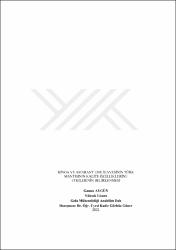| dc.contributor.advisor | Güner, Kadir Gürbüz | |
| dc.contributor.author | Aygün, Gamze | |
| dc.date.accessioned | 2022-04-06T06:49:41Z | |
| dc.date.available | 2022-04-06T06:49:41Z | |
| dc.date.issued | 2021 | |
| dc.identifier.uri | https://tez.yok.gov.tr/UlusalTezMerkezi/TezGoster?key=tqUiYt63sTQLTpozMJ92QuGroyBOKoILR6J5eSduJq3RfMjpxTP7HO9tta3dXuO0 | |
| dc.identifier.uri | https://hdl.handle.net/20.500.11776/4239 | |
| dc.description.abstract | Geleneksel olarak mantı üretimi, ülkemizde yaygın olarak tüketilen bir gıda maddesidir. Bu çalışmada; pseudo tahıl olarak bilinen kinoa ve amarant unları kullanılarak protein ve fenolik bileşenler açısından zenginleştirilmiş mantı üretilmiştir. Pseudo tahıllardan elde edilen unların mantıların kalite, teknolojik ve duyusal özelliklerine etkileri araştırılarak daha sağlıklı bir gıda ürünü geliştirilmesi hedeflenmektedir. Çalışma kapsamında buğday unu ile kombine edilmiş en uygun kinoa ve amarant kullanım oranının saptanması, elde edilen hamurun ürünün niteliklerine etkisi araştırılmıştır. Bu amaçla, %0, %5, %10, %15 ve %20 oranında kinoa ve amarant unları kullanılarak 9 farklı mantı hamuru elde edilmiştir. Hamurların pişme (pişme süresi, hacim ve ağırlık artışları, suda çözünen madde miktarı), fiziksel (renk), kimyasal (yağ, protein, toplam fenolik madde, antioksidan aktivite) ve duyusal özellikleri incelenmiştir. Kinoa ve amarant ilaveli mantı numunelerinde protein ve yağ oranının arttığı gözlemlenmiştir. En yüksek protein değeri %20 kinoalı mantıda %12,86, en yüksek yağ oranı ise %20 amarantlı mantı örneğinde %2,87 olarak tespit edilmiştir. Toplam fenolik madde miktarının ikame unların ilavesi ile arttığı görülmüş ve %20 kinoa içeren örnekte 31,34 mg GAE/100g, %20 amarant içeren mantı örneğinde ise 27,93 mg GAE/100g, olarak bulunmuştur. Antioksidant aktivite kinoa içeren mantı örneklerinde daha fazla gözlemlenmiş ve %20 kinoa içeren mantı örneğinde %44,67 olarak elde edilmiştir. Pişme testlerinde ise pişme süresi ikame unların miktarı ile artmış ve kinoa unu içeren mantı örneklerinde daha fazla olduğu görülmüştür. Renk parametrelerinde ise kinoa ilavesi arttıkça L* değerinin doğrusal olarak azaldığı gözlemlenmiş ve pişme prosesi ile tüm örneklerde L* değerinin azaldığı a* değerinin ise arttığı belirlenmiş ve bu değişim duyusal olarak olumlu karşılanmıştır. Son olarak gerçekleştirilen duyusal analizde tüm örnekler kabul sınırları içinde değerlendirilmiştir. | en_US |
| dc.description.abstract | Traditionally mantı producing include wheat flour is a widely consumed foodstuff in our country. In this study; by using quinoa and amaranth flours, known as pseudo-cereals was produced enriched mantı in respect to protein and phenolic components. It is aimed to develop a healthier food product by investigating the effects of these flours on the quality, technological and sensory properties of mantı. Within the scope of the study, the determination of the most suitable quinoa and amaranth usage ratio combined with wheat flour and the effect of the obtained dough on the quality of the mantı were examined. For this purpose, 11 different mantı were obtained by using 0%, 5%, 10%, 15% ,20% quinoa and amaranth flours. The baking prperties (cooking time, increase in volume and weight, amount of water-soluble substance), physical property (color), chemical properties (oil, protein, total phenolic substance, antioxidant activity) and sensory properties of mantı were researched. It was observed that the protein and fat ratios increased in the mantı samples with quinoa and amaranth added. The highest protein value was determined as 12.86% in the mantı consisting of with 20% quinoa and the highest fat ratio was determined as 2.87% in the mantı with 20% amaranth. It was concluded that the total amount of phenolic substance increased with the addition of substitute flours and it was found to be 31.34 mg GAE/100g, in the sample containing 20% quinoa and 27.93 mg GAE/100g, in the sample of mantı containing 20% amaranth. Antioxidant activity was revealed more in the quinoa mantı examples than others and highest value as 44.67% in the 20% quinoa mantı sample. According to the cooking tests; the cooking time increased with the amount of substitute flours and it was more in the mantı samples with quinoa flour. In the color parameters, it was obtained that the L* value of the mantı involving quinoa samples was lower than other samples. During the cooking process L* value decreased in all samples, while the a* value increased in all samples This colour change was perceived positive as sensorial by 10 panelists. Finally, all samples received a passing grade in the sensory analysis. | en_US |
| dc.language.iso | tur | en_US |
| dc.publisher | Tekirdağ Namık Kemal Üniversitesi | en_US |
| dc.rights | info:eu-repo/semantics/openAccess | en_US |
| dc.subject | Gıda Mühendisliği | en_US |
| dc.subject | Food Engineering | en_US |
| dc.subject | mantı | en_US |
| dc.subject | kinoa | en_US |
| dc.subject | amarant | en_US |
| dc.subject | geleneksel ürün | en_US |
| dc.subject | yalancı-tahıl | en_US |
| dc.subject | dumpling | en_US |
| dc.subject | quinoa | en_US |
| dc.subject | amaranth | en_US |
| dc.subject | tradional product | en_US |
| dc.subject | pseudo-cereal | en_US |
| dc.title | Kinoa ve amarant unu ilavesinin Türk mantısının kalite özelliklerine etkilerinin belirlenmesi | en_US |
| dc.title.alternative | Determination of the effects of quinoa and amarant flour addition on the quality traits of Turkish manti | en_US |
| dc.type | masterThesis | en_US |
| dc.department | Enstitüler, Fen Bilimleri Enstitüsü, Gıda Mühendisliği Ana Bilim Dalı | en_US |
| dc.identifier.startpage | 1 | en_US |
| dc.identifier.endpage | 108 | en_US |
| dc.institutionauthor | Aygün, Gamze | |
| dc.relation.publicationcategory | Tez | en_US |
| dc.identifier.yoktezid | 693034 | en_US |



















